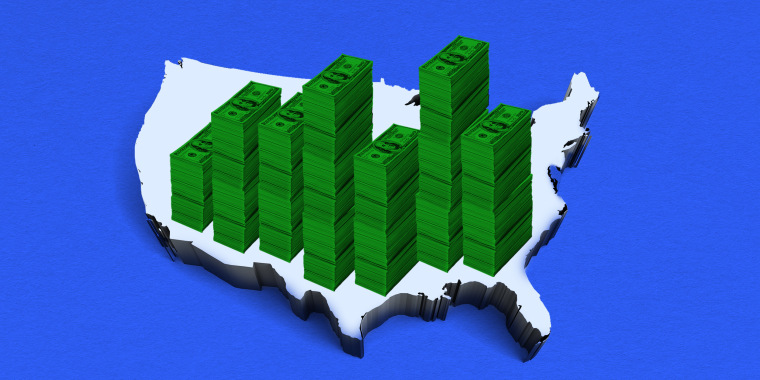Upon the news this week that America’s gross national debt now exceeds $31 trillion, Jason Furman, former director of the National Economic Council under Barack Obama, told The New York Times, “We were sort of at the edge of ‘OK’ before, and we are past ‘OK’ now. The deficit path is almost certainly too high.”
While Furman is rightly alarmed, you can practically taste the public’s profound ambivalence. For decades, the growing national debt has been the esoteric preoccupation of auditors and monetarist conservatives (who are themselves an endangered species within the increasingly populist Republican coalition).
As interest rates continue to rise, the administration shows little willingness to curtail its profligacy.
The lack of concern is a luxury, and luxuries are available only to those who can afford them. As long as interest rates were low and the U.S. dollar remained the world’s prohibitive reserve currency, Americans could afford to avoid worrying about the balance on the national credit card. But those conditions are changing, and our assumptions must change with them.
When Democrats in Congress spent the better part of the last two years spending trillions on various projects (and with every intention of spending much more), supporters of this unprecedented orgy of deficit spending argued that it was as good a time as any to borrow. As Furman himself, among others, said last year, “Interest rates remain really low,” so the federal government could borrow trillions “without causing a whole lot of problems” to the broader economy.
Yet now, as interest rates continue to rise, the administration shows little willingness to curtail its profligacy. Joe Biden signed the Inflation Reduction Act in August, which, the law’s name notwithstanding, is expected to increase inflationary pressure on the economy in the short-term, according to a University of Pennsylvania’s Wharton School analysis. That’s because the legislation front-loaded $485 billion in spending programs and tax breaks while counting on health care savings and additional tax revenues from a beefed-up IRS to reduce the deficit over 10 years. Most of the promised savings aren’t expected to be measurable until 2027. These gestures convey the necessity of deficit reduction without delivering it in a timely way.
Meanwhile, the interest payments on those vast sums and whatever else the government spends in a year keep growing. Those payments are added to a pile of must-spend outlays we appropriately refer to as “nondiscretionary spending.” Unlike, say, the defense budget, the interest the nation owes its creditors must be serviced. Every dollar we borrow at higher rates today must be paid back at those higher rates.
Add to the interest other nondiscretionary items, like entitlements (Social Security, Medicare and Medicaid), which already eat up trillions of the annual budget and are on a trajectory toward insolvency. With the interest on the debt already forecast to become the most expensive item on the federal budget and entitlement programs on an unsustainable path, the Congressional Budget Office projects $100 trillion in baseline deficits over the next 30 years “if current laws governing taxes and spending generally did not change.”
And that was before the Federal Reserve’s rate hikes, a concept that’s all but unheard of for younger Americans. It’s been decades since the U.S. has experienced a financial crisis that couldn’t be remedied with loose monetary policy. From the 9/11 attacks to the 2008 economic collapse to the pandemic, policymakers have chosen lower interest rates to increase liquidity and boost investor confidence.
That’s how a debt crisis would unfold: slowly at first, then all at once.
Not that higher rates by themselves will shake the public out of its sense of complacency when it comes to America’s ballooning debt. That would take a shock. But such an event isn’t unimaginable.
The Congressional Research Service estimates today that global central banks maintain about 60% of foreign exchange reserves in U.S. dollars. And 90% of transactions in foreign exchange markets are conducted in dollars. This is a mutually beneficial relationship: The dollar’s general stability hedges against volatility, and the strong demand for U.S. Treasury bonds helps hold down private borrowing costs.
The U.S. benefits tremendously from this privilege, and our near-peer competitors abroad resent it. Russian President Vladimir Putin has long lobbied for the creation of a parallel reserve currency that would bundle Russia’s ruble with the currencies of regional powers like Brazil, South Africa, India and China. Russia is in bad odor these days, but the desire abroad for a competitor to the dollar is widespread. In 2015, China created its own interbank payment system as an alternative to SWIFT (the Western-backed global standard for interbank payment messaging), and Beijing has enjoyed some success in its efforts to lobby Saudi Arabia to accept yuan instead of dollars for some oil purchases.
A long-forecast debt crisis in America is forever just over the horizon, so it is easy to compartmentalize the risk. But the conditions that prevail today are unnerving: an unserviceably large yet growing debt, tightening monetary policy, obstinately loose fiscal policy and global foes eager to undermine the dollar’s unique position.
As Financial Times analyst Ken Rogoff wrote in 2010, “It is folly to ignore the long-term risks of already record peace-time debt accumulation.” Even a “benign market environment can darken quite suddenly as a country approaches its debt ceiling,” and America “is likely to face a relatively sudden fiscal adjustment at some point if it does not put its fiscal house in order.” And that’s how a debt crisis would unfold: slowly at first, then all at once. To channel F. Scott Fitzgerald’s sense of foreboding on the eve of his age’s own financial disaster, a day will come when the crisis evolves from hypothetical to imminent. “But by that time, we were all pretty well committed,” he wrote. “We would all have one more.”
